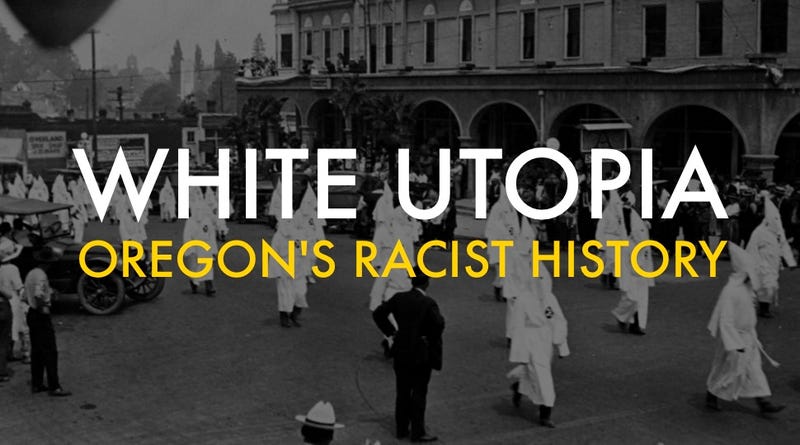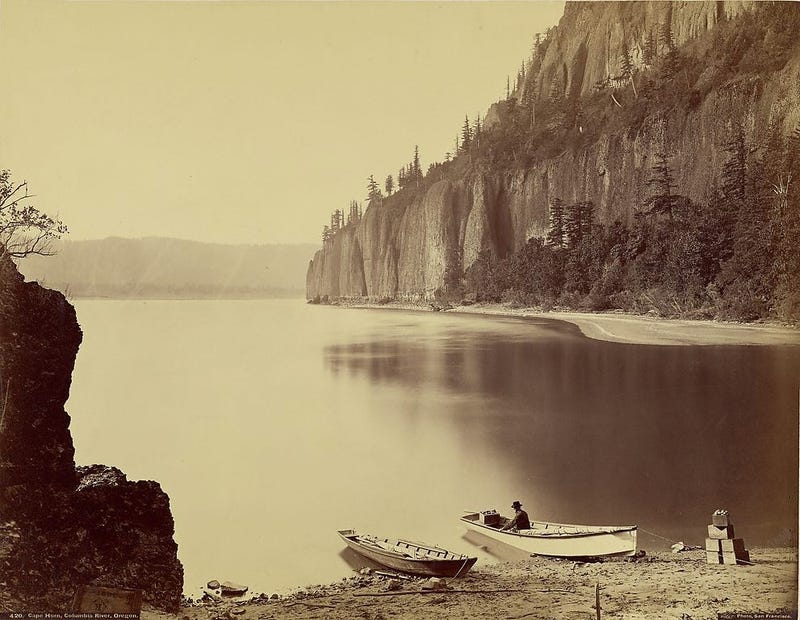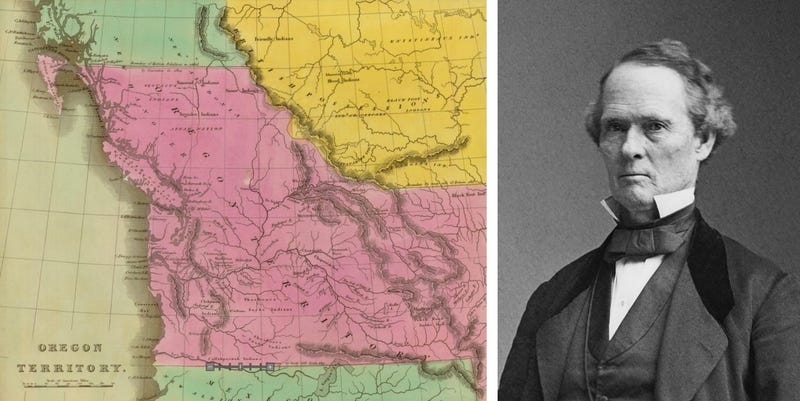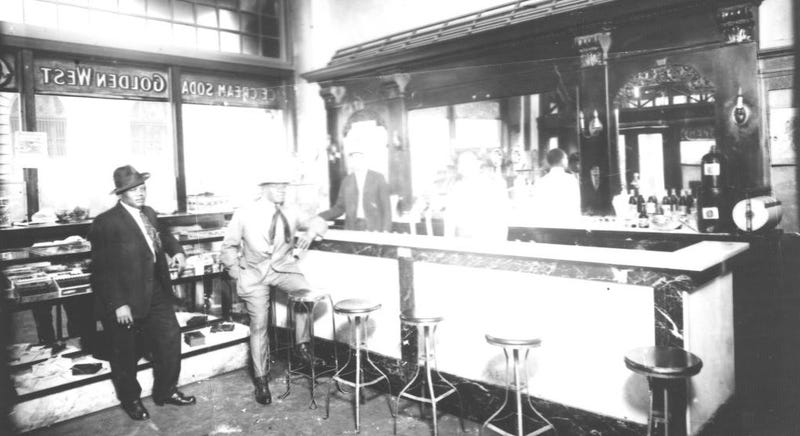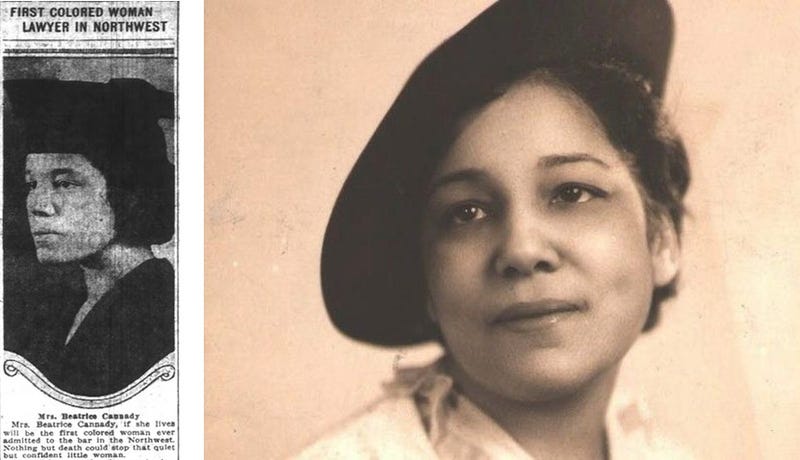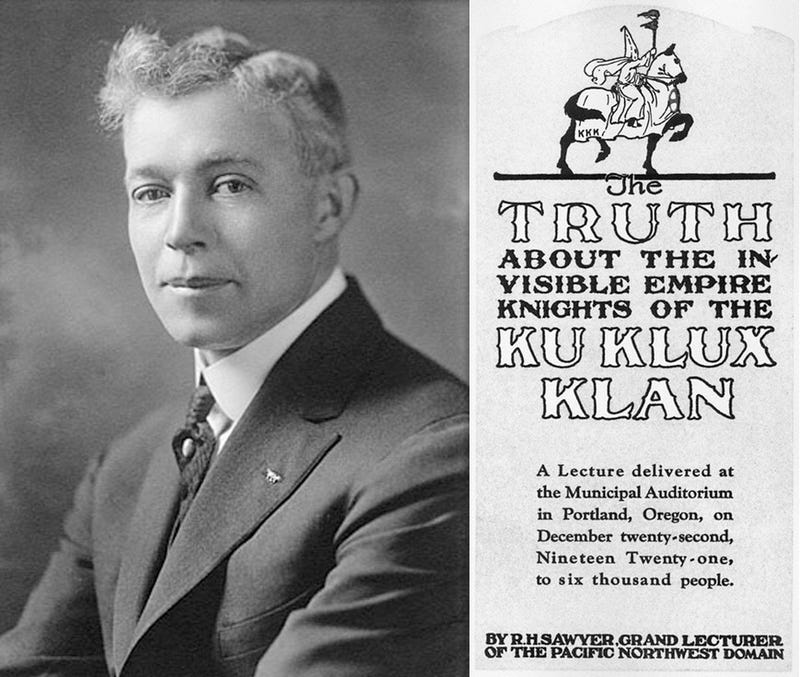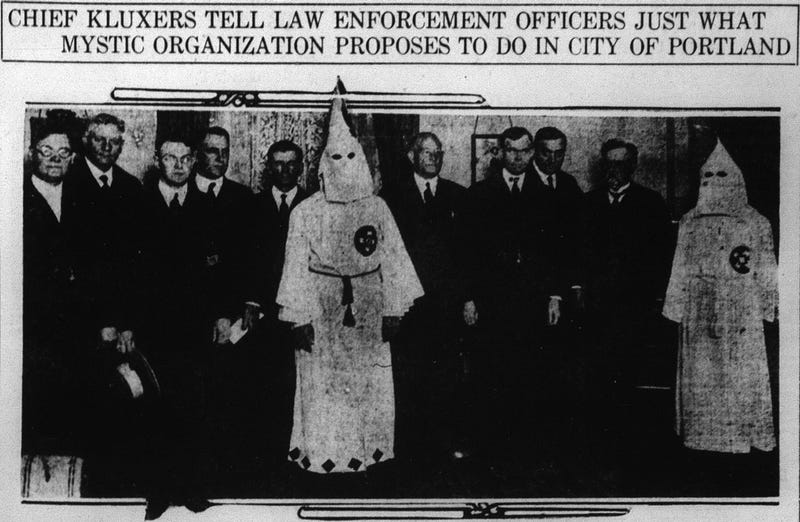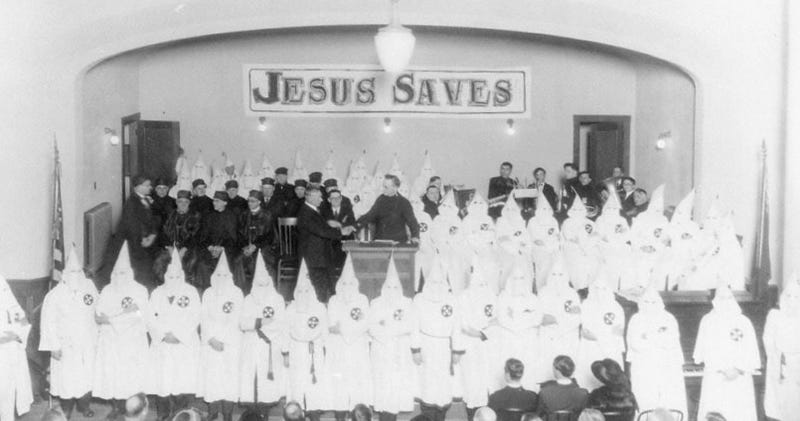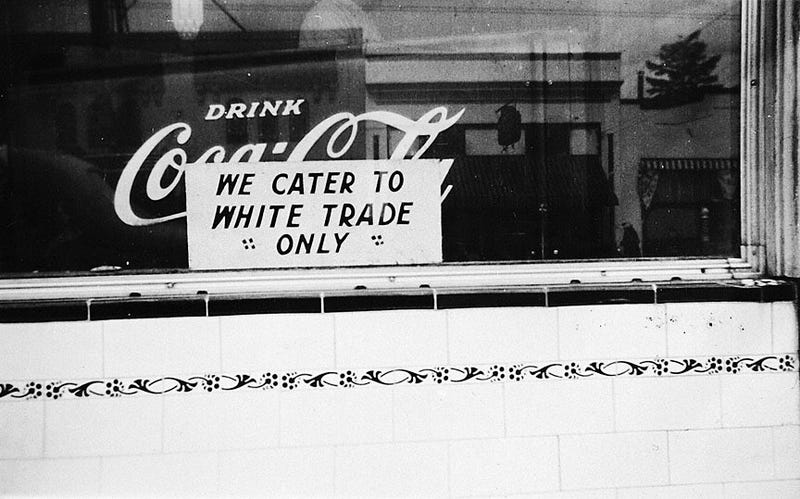![Oregon Was Founded As a Racist Utopia]()
When Oregon was granted statehood in 1859, it was the only state in the Union admitted with a constitution that forbade black people from living, working, or owning property there. It was illegal for black people even to move to the state until 1926. Oregon’s founding is part of the forgotten history of racism in the American west.
Waddles Coffee Shop in Portland, Oregon was a popular restaurant in the 1950s for both locals and travelers alike. The drive-in catered to America’s postwar obsession with car culture, allowing people to get coffee and a slice of pie without even leaving their vehicle. But if you happened to be black, the owners of Waddles implored you to keep on driving. The restaurant had a sign outside with a very clear message: “White Trade Only — Please.”
It’s the kind of scene from the 1950s that’s so hard for many Americans to imagine happening outside of the Jim Crow South. How could a progressive, northern city like Portland have allowed a restaurant to exclude non-white patrons? This had to be an anomaly, right? In reality it was far too common in Oregon, a state that was explicitly founded as a kind of white utopia.
America’s history of racial discrimination is most commonly taught as a southern issue. That’s certainly how I learned about it while going to Minnesota public schools in the 1980s and 90s. White people outside of the South seem to learn about the Civil War and civil rights movements from an incredibly safe (and often judgmental) distance.
Racism was generally framed as something that happened in the past and almost always “down there.” We learned about the struggles for racial equality in cities like Birmingham and Selma and Montgomery. But what about the racism of Portland, Oregon, a city that is still overwhelmingly white? The struggles there were just as intense — though they are rarely identified in the history books.
According to Oregon’s founding constitution, black people were not permitted to live in the state. And that held true until 1926. The small number of black people already living in the state in 1859, when it was admitted to the Union, were sometimes allowed to stay, but the next century of segregation and terrorism at the hands of angry racists made it clear that they were not welcome.
Oregon’s Trail to Whitopia
![Oregon Was Founded As a Racist Utopia]()
Cape Horn, Columbia River, Oregon photographed by Carleton Watkins in 1867 (Getty’s Open Content Program)
Oregon has had more than its fair share of utopia community experiments. The definitive book on the topic is Eden Within Eden: Oregon’s Utopia Heritage, where you’ll find plenty of those utopian communities catalogued. But the book kind of misses the forest for the trees in not recognizing the fact that the entire state of Oregon was founded as a kind of racist’s utopia. Race isn’t explored in the otherwise excellent book.
Thousands would travel to Oregon in the 19th and 20th centuries, looking for their own versions of utopia. Some brave and noble people made the journey that would become cartoonishly immortalized for at least three generations now in the computer game Oregon Trail. But unfortunately for people of color, that pixelated utopia and vision of the promise land was explicitly designed to exclude them in real life.
This is not to pick on Oregon in particular as being particularly racist and terrible. The de facto exclusion of any non-white people from a number of businesses, institutions, and communities occurred throughout the Northeast, Midwest, and West. Oregon seems to have been just a bit more vocal and straightforward about it.
I spoke over the phone with Walidah Imarisha, an educator and expert on black history in Oregon and she was quick to explain that the state is only really exceptional in that it bothered to proclaim its goals of white supremacy so openly.
“What’s useful about Oregon as a case study is that Oregon was bold enough to write it down,” Imarisha told me. “But the same ideology, policies, and practices that shaped Oregon shaped every state in the Union, as well as this nation as a whole.”
Today, while 13 percent of Americans are black, just 2 percent of Oregon’s population is black. This is not some accident of history. It’s a product of oppressive laws and everyday actions that deliberately excluded non-white people from a fair shot at living a life without additional obstacles being put in their way.
Life’s hard enough as it is. But life as a person of color in Oregon would prove to be like trying to play Oregon Trail in a roomful of Klansmen while the computer lab is on fire.
The Messy Birth of Oregon
![Oregon Was Founded As a Racist Utopia]()
Oregon territorial map from 1840 (David Rumsey) Joseph Lane, the first territorial governor of Oregon (Wikipedia)
The question of whether Oregon should allow slavery dates back to at least the 1840s. The majority of Oregonians (which is to say the territory’s new white residents who were systematically and sometimes violently oppressing its Native peoples) opposed slavery. But they also didn’t want to live anywhere near anyone who wasn’t white.
Even before it was a state, those in power in Oregon were trying to keep out non-white people. In the summer of 1844, for example, the Legislative Committee passed a provision that said any free black people who were in the state would be subject to flogging if they didn’t leave within two years. The floggings were supposed to continue every six months until they left the territory. That provision was revised in December of 1845 to remove the flogging part. Instead, free black people who remained would be offered up “publicly for hire” to any white person who would remove them from the territory.
It seems to me unclear if that provision meant that free blacks would be auctioned off as slaves to people who were on their way out of Oregon. But one thing is clear: the territorial statutes would become irrelevant the following decade when Oregon would formally write its constitution. And that document was no more generous to the tiny black population.
The legislative founders of Oregon weren’t exactly the cream of the crop as statesmen. Many of the sixty men who drafted the state’s constitution loved to ramble on for hours making bold speeches about minor points of order. One significant subject of debate was how long members of the new government should be allowed to debate for. One particularly long-winded gentleman complained that he was just getting warmed up after 45 minutes.
These guys had plenty to say, but when it came to actually writing a constitution, they were pretty damn lazy. In fact, 172 of the document’s 185 sections were directly plagiarized from the constitutions of other states like Ohio and Indiana.
The original parts? As David Schuman explains in his 1995 paper The Creation of the Oregon Constitution, they fell into two camps: limits on state spending and forms of racial exclusion. Somewhat ironically, the racial exclusion sections were included in an article called the Bill of Rights.
The constitution was put to a popular vote in the state in 1857 and included two referendums that were to be voted on independently. The first was whether they should reject slavery. Roughly 75 percent of voters opted to reject the adoption of slavery. The second measure was whether or not to exclude black people from the state. About 89 percent of voters cast their vote in favor of excluding black and mixed race people from the state. And thus, the exclusionary aspects of the state constitution were adopted.
The resulting Article 1, Section 35 of the Oregon state constitution:
No free negro, or mulatto, not residing in this State at the time of the adoption of this Constitution, shall come, reside, or be within this State, or hold any real estate, or make any contracts, or maintain any suit therein; and the Legislative Assembly shall provide by penal laws, for the removal, by public officers, of all such negroes, and mulattoes, and for their effectual exclusion from the State, and for the punishment of persons who shall bring them into the state, or employ, or harbor them.
The voters who overwhelmingly embraced this exclusion rationalized it not as blind hate, but as a progressive move that was simply keeping their new land “pure.” Utopia often means starting from scratch, and just as often it means excluding undesirables.
As one “pioneer” voter who would later become a Republican state senator and a member of the U.S. House explained at a reunion in 1898:
Some believers in the doctrine of abstract human rights interpret this vote against admission of free negroes as an exhibition of prejudices which prevailed agains the African who was not a slave, but I have never so regarded it. It was largely an expression against any mingling of the white with any of the other races, and upon a theory that as we had yet no considerable representation of other races in our midst, we should do nothing to encourage their introduction. We were building a new state on virgin ground; it’s people believed it should encourage only the best elements to come to us, and discourage others.
This language about virgin ground and “the best elements,” burned into law in the new state, was used as a recruitment tool for other white Americans in the latter half of the 19th century — many of whom were white “refugees” from the south who were fleeing the dissolution of slavery.
“If you look at some of the recruiting materials, in essence they’re saying come and build the kind of white homeland, the kind of white utopia that you dream of,” Imarisha said. “Other communities of color were also controlled, not with exclusion laws, but the populations were kept purposefully small because the idea behind it was about creating explicitly a white homeland.”
Technically the state’s exclusion laws were superseded by federal law after the Fourteenth Amendment was adopted. But Oregon had a rather complicated relationship with that particular Amendment. Having ratified it in 1866, the state then rescinded its ratification when a more racist state government took control in 1868. The move was more symbolic than anything, but Oregon gave the sign that it wasn’t on board with racial equality. Astoundingly, it wouldn’t be until 1973 (and with very little fanfare) that activists would get the state to ratify the Fourteenth Amendment yet again.
Naturally, the state’s quest for an all-white utopia also included the oppression of other groups — especially those of Chinese and Japanese descent. Though Asian people were not specifically called out in Oregon’s constitutional exclusion laws, the white people of many towns large and small did their best to drive out non-white people any time they got the chance.
As just one example, the white people of La Grande burned that city’s Chinatown to the ground in 1893. The Chinese residents fled, with some people getting on the first train out. But some Chinese residents weren’t about to be intimidated and set up camp nearby. This wasn’t enough for the hateful mobs of La Grande, who broke up the camp and forced anyone remaining to get on trains out of town.
These efforts were decentralized and not officially sanctioned by the state. But as the 1910s and 20s would roll around, a new domestic terror group would re-emerge to expel, harass, and brutalize anyone who wasn’t “100 percent American.” Some pioneers of the era weren’t going to stand for it.
The Golden West and a Place to Belong
![Oregon Was Founded As a Racist Utopia]()
Golden West soda fountain circa 1920s (Oregon Encyclopedia)
As rare as the presence of non-white faces were in the 19th and early 20th century, Oregonians of color found sanctuary in the few places that they were welcome.
The Golden West Hotel was unique in that it was owned, operated, and exclusively patronized by black people in Oregon. It was the only place that black people from out of town could rent a room, and it was the central hub of black entertainment, recreation, and dining in Portland.
First opened in 1906, Portland authorities continually tried to shut down the place on trumped up charges of prostitution, gambling, and later for not having the “proper licenses.”
When the owners of the Golden West were forced to plea for their license back in 1921 they “pointed out that the hotel and club was practically the only place in the city where negroes could congregate.”
Renting a room or patronizing the Golden West’s many businesses on the first floor didn’t mean that you would live without harassment from Portland’s white population. But it did prove to be one of the few places in the city outside of church where black people could find a sense of community.
Beatrice Morrow Cannady and the Struggle in Oregon
![Oregon Was Founded As a Racist Utopia]()
Cannady in a 1922 newspaper article with a rather cryptic note about her possible death (Oregon Daily Journal) Beatrice Morrow Cannady in an undated photo (Oregonian Archives)
“The way this history gets framed often shows people of color as passive victims,” Imarisha tells me. “I think it’s important to frame it that people of color are actually active change makers. The changes that would’ve moved Oregon forward, especially racially, would not have happened without the determination, fortitude, and sheer stubbornness of people of color.”
One of those people was Beatrice Morrow Cannady. Born in Texas in 1889, Cannady hopped around the country a bit, attending schools in New Orleans and Houston before moving to the Portland in 1912 and before long she was writing for The Advocate, Oregon’s largest black newspaper. By 1914 Cannady was helping to found the Portland chapter of the NAACP and the following year was speaking out against D.W. Griffith’s feature length film The Birth of a Nation — a movie filled with hateful stereotypes and glorified the resurgence of the Ku Klux Klan.
Cannady’s life was filled with personal and professional struggles that seemed neverending. She and her children were refused entry to the main floor of the Oriental Theatre in 1928. And it wasn’t even illegal. The Oregon Supreme Court had decided in the 1906 case Taylor v. Cohn that black people could be legally segregated from whites in public places. That particular ruling wasn’t struck down in the state until 1953, and even then limits on segregation in the state were only loosely enforced.
Kimberley Mangun’s 2010 biography of Cannady, A Force For Change, is both inspiring and depressing. Cannady’s story is one of tiny victories hard fought over an incredibly long period of time. Frankly, that’s the overwhelming thing about all social and political change. Virtually nothing happens overnight.
But if Cannady’s story teaches us anything it’s that if you work your ass off and foster a community where people can be a force for good, you too can eventually (one day, maybe, possibly) see minor improvements in the world.
It was in small victories that Oregonians of color had to take solace in the first few decades of the 20th century. Because once the early 1920s hit, the battle for the future of Oregon would involve a group of terrorist cowards who liked to dress up in their bedsheets and burn shit.
The Kowards of the Klavern Arrive
![Oregon Was Founded As a Racist Utopia]()
Frederick Louis Gifford, head of the Oregon KKK (1921-24) and a Klan pamphlet (Oregon History Project)
The arrival of the Ku Klux Klan in Oregon was swift and terrifying. In 1922 the Klan in Oregon boasted membership of over 14,000 men, with 9,000 of them living in Portland. And they were setting the state aflame. There were frequent cross burnings on the hills outside Portland and around greater Oregon.
The Klan held meetings, openly participated in parades, and held enormous gatherings for initiation ceremonies. One such gathering in 1923 at the Oregon State Fairgrounds in Salem attracted over 1,500 hooded klansmen. They reportedly burned an enormous cross, of course.
As David A. Horowitz explains in his book Inside the Klavern: The Secret History of a Ku Klux Klan of the 1920s, the entire state was being terrorized. And politicians at every level of government from the state to county to city officials were involved. In 1923, Oregon governor, Walter M. Pierce, and Portland mayor George L. Baker, attended and spoke at a dinner in honor of Grand Dragon Frederick L. Gifford’s birthday.
Both the governor and mayor would later claim that they didn’t know the event was sponsored by the Klan. Which, if true, is perhaps less vindication for the politicians and more an indictment of just how far the Klan had seeped into mainstream culture in Oregon. But there’s almost certainly no way that they were ignorant of what they were celebrating.
One reason to be skeptical? High ranking members of the Klan would meet with high ranking politicians in the state on matters of public policy. And we have the photos to prove it.
![Oregon Was Founded As a Racist Utopia]()
Members of the Klan meeting with Portland officials in 1921 (North Coast Oregon)
The August 2, 1921 issue of the Portland Telegram included a photo of Portland city and Multnomah county officials with two Klan members. The mayor of Portland, George L. Baker, is third from the right and the police chief, L.V. Jenkins, is third from the left.
The Telegram was one of the few newspapers in Oregon to openly oppose the Klan at the height of its power in the state. Despite being owned by white Protestant men, the newspaper’s adversarial stance against the Klan’s terrorism brought concerted campaigns to boycott businesses that advertised in the paper. The paper hemorrhaged thousands of readers and when it folded in 1933 many reportedly blamed the Klan’s efforts.
The Klan themselves counted men like Governor Pierce as members in secret minutes obtained in 1968 from the estate of a former state legislator. Colon R. Eberhard died at the age of 86 and while his personal papers were being processed, a folder of over 200 pages of KKK meetings in Oregon was discovered, dating from 1922 until 1924. Those pages weren’t handed over to the Oregon Historical Society until 1980. Public mention of their existence wouldn’t happen until an article in The Observer newspaper in 1985. Klan membership lists were highly secretive, but politicians like Pierce were discussed in the minutes as being loyal KKK members.
But the Klan’s presence in Oregon was far from a secret, even in the 1920s. Not only were the hooded cowards meeting with law enforcement, they were advising them on what they’d like to accomplish — all while getting their picture in the newspaper. As the Telegram would report, the Portland police department was “full to the brink with Klansmen.”
![Oregon Was Founded As a Racist Utopia]()
Portland Klan meeting in the early 1920s (Oregon History Project)
The warped thing about the Klan’s presence in Oregon is just how few people of color were actually living there in the 1920s. The town of La Grande as just one example, which as you’ll recall had burned its Chinatown to the ground back in the 1890s, had about 7,000 people in 1920 and just forty-six people of Chinese descent. The town had a mere 15 black people.
People of color were naturally a target for the Klan during this period, but with so few people to irrationally hate for the color of their skin, they turned to campaigns against other groups like Catholics. The Klan, being for American-born Protestants, hated the Roman Catholic church and any of its followers.
Hate is a fickle game when there are so few “others” upon which to focus your gaze. The homogenous state of Oregon was fertile ground to whip young white men into a frenzy. But almost as quickly as it was whipped up, men who were surrounded by so many men like themselves quickly lost interest. People stopped paying dues, leading to a financial crisis within the quickly built organization. By 1926 the Klan in Oregon was a shadow of its former self.
White Oregon After the Klan
![Oregon Was Founded As a Racist Utopia]()
Sign in the window of a Portland restaurant circa 1943 (Oregon Historical Society)
Of course, the discrimination didn’t stop after the decline of the Klan. White restaurants still wouldn’t serve black people in Portland, black people weren’t allowed in the city’s swimming pools, and the local skating rink set aside a day for black people. This was as late as the early 1960s.
“I do remember the signs downtown: ‘We don’t serve Negroes, Jews or dogs’,” one man recounts in a 1999 documentary from Oregon Public TV titled Local Color. The signs were everywhere. And they spanned over two world wars. War attracted soldiers from out of town, both black and white. Their arrival naturally led to resentment from soldiers who were used to a more tolerant atmosphere than Oregon provided.
The Oregon Daily Journal reported on some black soldiers from California who in the summer of 1918 were angered by a sign they saw in the window of a restaurant in Portland. The sign read, “We employ white help and cater to white trade only.” The soldiers entered the restaurant and destroyed the sign. Similarly in 1943, soldiers going off to fight in World War II saw signs in Portland and were outraged.
The segregation in Portland was as stark as anything in the Jim Crow-era South. And Portland’s bizarre dearth of black people (bizarre to outsiders who were unaware of the climate) really came to a head during World War II, when an influx of black workers came looking for the plentiful jobs offered by the Kaiser Shipyards.
“Portland was called the most segregated city north of the Mason-Dixon line,” Imarisha tells me. “And so the question became where would these [newly arrived black workers] go? Suddenly you have tens of thousands of black folks pouring in when in Portland there was only one tiny neighborhood called the Albina neighborhood that was already overfull with about 2,500 black folks.”
The company worked with the city to create Vanport, an enormous new housing development halfway between Vancouver, Washington and Portland — thus the name Vanport.
“At its height there was 100,000 people there and it was 40 percent black, which for anything to be 40 percent black in Oregon was astounding, Imarisha explains. “Vanport was built incredibly shoddily because it was never meant to last.”
This temporary insta-town would become Oregon’s second largest city, second only to Portland during the second World War.
“In fact the housing authority in Portland called it a blight and wanted Vanport obliterated. And in 1948 they got their wish when Vanport was completely flooded.” Imarisha says. Amazingly, the flooding actually started modestly and people had time to leave. But Portland officials insisted that there was nothing to worry about when the first cracks started letting water into the community.
“Remember: Dikes are safe at present,” a bulletin from the Portland Housing Authority read on May 30, 1948. “You will be warned if necessary. You will have time to leave. Don’t get excited.”
People were not warned in time and the city was flooded as the dikes fully gave way. Fifteen people would die in the floods. Less than two weeks later President Truman would travel to Vanport to see the extent of the damage firsthand.
“Because it was made with shoddy material, houses literally washed away off their foundations. All of Vanport was destroyed and about 18,000 people who were living there were left homeless.”
The Clash of History and Future in the Pacific Northwest
![Oregon Was Founded As a Racist Utopia]()
Ken Webber of Medford, Oregon wears a confederate flag hat and shows the Confederate flag that got him fired as a school bus driver in 2012 (AP)
Oregon today still exists as a white utopia in some respects. The state, much like so many others, is haunted by the residue of less explicit experiments in whitopia. These experiments form the basis of Rich Benjamin’s 2009 book Searching for Whitopia: An Improbable Journey to the Heart of White America.
In it, Benjamin travels the country, visiting places that are overwhelmingly white. He meets fascinating characters along the way, and helps to explain places like Oregon and how the actions of the 19th and 20th century bleed into the 21st.
From Searching for Whitopia:
Through most of the twentieth century, racial discrimination was deliberate and intentional. Today, racial segregation and division often result from habits, policies, and institutions that are not explicitly designed to discriminate. Contrary to popular belief, discrimination or segregation do not require animus. They thrive even in the absence of prejudice or ill will.
It’s common to have racism without “racists.”
I called Benjamin on the phone to talk about his book and what he experienced in the Pacific Northwest. He was quick to tell me that he met lots of interesting, lovely people in the region. But he was also unsettled by the unmistakable symbols of our country’s racist history.
“There is and was some sense that the Pacific Northwest could amount to some form of utopia,” Benjamin tells me referring to the white supremacist movement in the region. “And Richard Butler knew this himself, the old founder of Aryan Nations.”
Butler died in 2004, but was obsessed as so many other white nationalist militants were, with establishing a white utopia in the area. Butler, much like the founders of Oregon, bothered to write it down.
“He identified the Pacific Northwest as what would become an Aryan homeland,” Benjamin says. “So the Pacific Northwest has always had a utopic quality to white separatists.”
“On the one hand, I saw a lot of can-do spirit, therefore one shouldn’t be surprised by all of the technological start-ups both in Oregon and in Washington State. But I also saw a lot of Confederate refugees, to be frank,” Benjamin tells me.
“I remember driving through swaths of Washington and Oregon and seeing a lot of Confederate flags,” he says. “There are a lot of refugees from the South who I guess are attracted to Oregon not because they’re racists but Oregon had a racial homogeneity and a conservatism and a gun culture that they really appreciate.”
The Pacific Northwest offers a collision of the old and the new in so many forms. But there’s something particularly disturbing about his description of the juxtaposition you can see in tech hubs — the romanticization of some particularly backwards symbols of a revolution that’s supposed to be long since dead, yet nurtured in the very land that’s supposed to be creating the industries of tomorrow.
“That was shocking, to drive through Oregon and witness so many Confederate flags, juxtaposed with the high-tech futurism,” Benjamin tells me.
Oregon’s White Utopian Promise Today
![Oregon Was Founded As a Racist Utopia]()
Senator Barack Obama looks out to a sea of supporters in Portland on May 18, 2008 (AP)
As Neda Maghbouleh pointed out for an article in the January 2009 issue of Center for New Racial Studies, the 2008 presidential campaign of Barack Obama gave Portland newspapers a striking image of its racial makeup. Just look at the photo above from Portland during Senator Obama’s presidential campaign. You’d be forgiven for thinking that maybe Dave Matthews Band was about to go on stage.
The racial composition of any American city is a product of its history. This may seem painfully obvious, but it’s something that we need to say out loud and type in bold letters to fully appreciate. The racial composition of any American city is a product of its history. And its a history that so many people in Oregon, in Minnesota, in any other “whitopia” don’t seem to be privy to.
The title of Imarisha’s most commonly given presentation is Why Aren’t There More Black People in Oregon? A Hidden History. She has given the presentation to thousands of people around Oregon over the past four years and she’s understandably frustrated that so few Oregonians are aware of something so fundamental to the state’s founding. Oregon’s history simply isn’t being taught in most Oregon schools. And it’s because even the teachers have no idea.
“It’s still a hidden history today. It’s not part of the curriculum that’s being taught in public schools in this state. I, in fact, gave a presentation that was mostly public school administrators and public school teachers and I asked them how many of them had known about the exclusionary law before they came to the presentation. Seventy to eighty percent didn’t know that Oregon had racial exclusion laws,” she tells me.
“The image that the rest of the nation has about Portland is founded a lot on the show Portlandia, right? Keep Portland weird — this sort of idea of this being a white liberal playground. And it’s predicated on racial exclusionary laws and the surplus resources that were purposefully kept from communities of color that were redirected into the white community.”
This humble blog post barely scratches the surface of the black experience in Oregon, be it the 19th century, 20th century, or today. And it truly isn’t meant to pick on Oregon as a lone destination of warped quasi-utopian intolerance. But as Imarisha said, they bothered to write it down.
It’s time for white northerners to wake up to the sometimes uncomfortable history of what are now liberal enclaves like Minneapolis, Minnesota and Portland, Oregon and Madison, Wisconsin. There are stories there that may surprise you. Even if the people committing heinous acts didn’t write down their intentions first.
Secondary sources: Ku Klux Klan in the City, 1915-1930 by Keneth T. Jackson (1967); A Force For Change: Beatrice Morrow Cannady and the Struggle for Civil Rights in Oregon, 1912-1936 by Kimberley Mangun (2010); Women in Pacific Northwest History edited by Karen J. Blair (1988); Inside the Klavern: The Secret History of a Ku Klux Klan of the 1920s edited by David A. Horowitz (1999); Race, Politics and Denial: Why Oregon Forgot to Ratify the Fourteenth Amendment by Cheryl A. Brooks (2004); The Creation of the Oregon Constitution by David Schuman (1995); Unwelcome Settlers: Black and Mulatto Oregon Pioneersby K. Keith Richard (1983); Negroes and Their Institutions in Oregon by Thomas C. Hogg (1969); Black Families and Migration to a Multiracial Society: Portland Oregon, 1900-1924 by William Toll (1998); A Great Inheritance, A Special Destiny: Barack Obama’s Candidacy and the Performance of Racial History in Portland, Oregon by Neda Maghbouleh (2009); “Promised Land” or Armageddon? History, Survivalists, and the Aryan Nations in the Pacific Northwest by Eckard Toy (1986); Matthew Deady and the Federal Judicial Response to Racism in the Early West by Ralph James Mooney (1984)




































